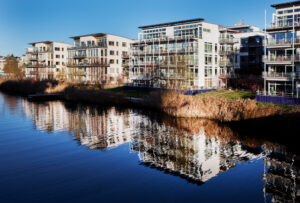Buildings consume around 40% of the total energy production in the European Union. Every year the building sector is expanding, increasing its associated footprint in terms of energy consumption. To limit energy dependency and associated emissions, smarter and more sustainable solutions for the building sector must be prioritized by both the public and private sectors.
Although Sweden has come a long way in developing innovative and sustainable products, the essence of the Swedish way of working with sustainability is not on the product level, but at the system level. As the understanding of energy efficiency and sustainability has evolved, the focus of sustainability has shifted from products to looking at sustainability from a more holistic point of view. Seen in this context, the efforts towards making the building sector sustainable and efficient are shifting – from making individual buildings sustainable to a systematic approach that aims to make a more sustainable built environment.

Image by Melker Dahlstrand/imagebank.sweden.se
The “smart buildings” of the future are made possible through the integration of innovative technologies, offering unprecedented control and customisation. This can lead to achieving improved operational efficiency, cost savings, and generating valuable data sets.
Sweden is known for its well-developed cooperation between stakeholders in the building sector and the public sector, such as the Swedish Energy Agency and the research community. More specifically, this collaboration has flourished through networks for residential and commercial property owners. One notable outcome of this cooperation is the development of an effective method called technology procurement, which promotes innovation and facilitates technology diffusion that encourages energy efficiency.
The goal of each technology procurement is to ensure that the developed products are actually ordered and implemented. This process-oriented working method normally consists of the following steps:
- A pilot study
- Creation of an expert group of client organizations who develop a clear technical specification that meets their requirements
- Procurement and tendering
- Evaluation of tender offers
- The naming of a winner
- Diffusion of the new technology among stakeholders
Since the start of these networks 30 years ago, they have played an important role in adopting new standards for energy efficiency in products, such as combined freezer/cooler-refrigerators and water-saving taps, to name a few.
Sweden can offer a variety of places suitable for site visits that showcase smart and sustainable building solutions. One of the most well-known examples is Hammarby Sjöstad, which has been a forerunner in terms of sustainability and systems thinking since the early 2000s.
1948: Sweden’s first district heating system was taken into operation in Karlstad.
1965-1974: Approximately one million housing units were built to meet the growing demand for housing in Sweden.
1973: The global oil crises led to multiple policies aiming to reduce the oil dependency.
1989: The network for residential property owners BeBo was established by the Swedish Energy Agency.
1990: The first model of the so-called technology procurement for specific technical challenges in buildings was implemented.
2001: Sweden’s first passive house was built.
2017: Near-zero energy regulations were introduced in the Swedish Housing Agency’s building regulations which pushed the development of passive housing and promotes the use of renewable energy.